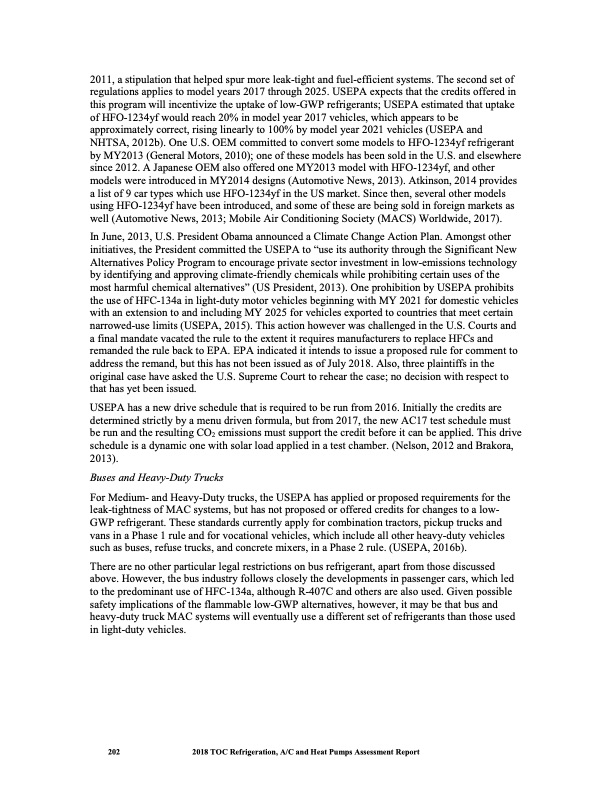
PDF Publication Title:
Text from PDF Page: 215
2011, a stipulation that helped spur more leak-tight and fuel-efficient systems. The second set of regulations applies to model years 2017 through 2025. USEPA expects that the credits offered in this program will incentivize the uptake of low-GWP refrigerants; USEPA estimated that uptake of HFO-1234yf would reach 20% in model year 2017 vehicles, which appears to be approximately correct, rising linearly to 100% by model year 2021 vehicles (USEPA and NHTSA, 2012b). One U.S. OEM committed to convert some models to HFO-1234yf refrigerant by MY2013 (General Motors, 2010); one of these models has been sold in the U.S. and elsewhere since 2012. A Japanese OEM also offered one MY2013 model with HFO-1234yf, and other models were introduced in MY2014 designs (Automotive News, 2013). Atkinson, 2014 provides a list of 9 car types which use HFO-1234yf in the US market. Since then, several other models using HFO-1234yf have been introduced, and some of these are being sold in foreign markets as well (Automotive News, 2013; Mobile Air Conditioning Society (MACS) Worldwide, 2017). In June, 2013, U.S. President Obama announced a Climate Change Action Plan. Amongst other initiatives, the President committed the USEPA to “use its authority through the Significant New Alternatives Policy Program to encourage private sector investment in low-emissions technology by identifying and approving climate-friendly chemicals while prohibiting certain uses of the most harmful chemical alternatives” (US President, 2013). One prohibition by USEPA prohibits the use of HFC-134a in light-duty motor vehicles beginning with MY 2021 for domestic vehicles with an extension to and including MY 2025 for vehicles exported to countries that meet certain narrowed-use limits (USEPA, 2015). This action however was challenged in the U.S. Courts and a final mandate vacated the rule to the extent it requires manufacturers to replace HFCs and remanded the rule back to EPA. EPA indicated it intends to issue a proposed rule for comment to address the remand, but this has not been issued as of July 2018. Also, three plaintiffs in the original case have asked the U.S. Supreme Court to rehear the case; no decision with respect to that has yet been issued. USEPA has a new drive schedule that is required to be run from 2016. Initially the credits are determined strictly by a menu driven formula, but from 2017, the new AC17 test schedule must be run and the resulting CO2 emissions must support the credit before it can be applied. This drive schedule is a dynamic one with solar load applied in a test chamber. (Nelson, 2012 and Brakora, 2013). Buses and Heavy-Duty Trucks For Medium- and Heavy-Duty trucks, the USEPA has applied or proposed requirements for the leak-tightness of MAC systems, but has not proposed or offered credits for changes to a low- GWP refrigerant. These standards currently apply for combination tractors, pickup trucks and vans in a Phase 1 rule and for vocational vehicles, which include all other heavy-duty vehicles such as buses, refuse trucks, and concrete mixers, in a Phase 2 rule. (USEPA, 2016b). There are no other particular legal restrictions on bus refrigerant, apart from those discussed above. However, the bus industry follows closely the developments in passenger cars, which led to the predominant use of HFC-134a, although R-407C and others are also used. Given possible safety implications of the flammable low-GWP alternatives, however, it may be that bus and heavy-duty truck MAC systems will eventually use a different set of refrigerants than those used in light-duty vehicles. 202 2018 TOC Refrigeration, A/C and Heat Pumps Assessment ReportPDF Image | Heat Pumps Technical Options

PDF Search Title:
Heat Pumps Technical OptionsOriginal File Name Searched:
RTOC-assessment-report-2018_0.pdfDIY PDF Search: Google It | Yahoo | Bing
CO2 Organic Rankine Cycle Experimenter Platform The supercritical CO2 phase change system is both a heat pump and organic rankine cycle which can be used for those purposes and as a supercritical extractor for advanced subcritical and supercritical extraction technology. Uses include producing nanoparticles, precious metal CO2 extraction, lithium battery recycling, and other applications... More Info
Heat Pumps CO2 ORC Heat Pump System Platform More Info
| CONTACT TEL: 608-238-6001 Email: greg@infinityturbine.com | RSS | AMP |